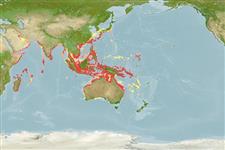>
Carangiformes (Jacks) >
Carangidae (Jacks and pompanos) > Caranginae
Etymology: Selaroides: A Malay vernacular name, ikan selar + Greek, suffix, oides = similar to.
More on author: Cuvier.
Environment: milieu / climate zone / depth range / distribution range
Ecologia
marino; salmastro associati a barriera corallina; amfidromo (Ref. 51243); distribuzione batimetrica 1 - 50 m (Ref. 90102). Tropical; 39°N - 34°S, 49°E - 170°E (Ref. 54888)
Indo-West Pacific: Persian Gulf to the Philippines, north to Japan, south to the Arafura Sea (Ref. 9819) and Australia (Ref. 3287).
Length at first maturity / Size / Peso / Age
Maturity: Lm 11.9, range 10 - ? cm
Max length : 22.0 cm TL maschio/sesso non determinato; (Ref. 28620); common length : 15.0 cm TL maschio/sesso non determinato; (Ref. 9137); peso massimo pubblicato: 625.00 g (Ref. 4883)
Spine dorsali (totale): 9; Raggi dorsali molli (totale): 24-26; Spine anali 3; Raggi anali molli: 21 - 23.
Adults occur in inshore waters of the continental shelf (Ref. 7300). They form large demersal schools over soft bottom habitats at depths shallower than 50 m. Sometimes they ascend into freshwater reaches like the freshwater tidal zone in the Mekong delta (Ref. 12693). Ostracods, gastropods and euphausiids are common prey but small fish are also taken.
Life cycle and mating behavior
Maturità | Riproduzione | Deposizione | Uova | Fecundity | Larve
Paxton, J.R., D.F. Hoese, G.R. Allen and J.E. Hanley, 1989. Pisces. Petromyzontidae to Carangidae. Zoological Catalogue of Australia, Vol. 7. Australian Government Publishing Service, Canberra, 665 p. (Ref. 7300)
IUCN Red List Status (Ref. 130435)
Threat to humans
Harmless
Human uses
Pesca: commerciale
Strumenti
Special reports
Download XML
Fonti Internet
Estimates based on models
Preferred temperature (Ref.
123201): 25.1 - 29.3, mean 28.6 °C (based on 2984 cells).
Phylogenetic diversity index (Ref.
82804): PD
50 = 1.0000 [Uniqueness, from 0.5 = low to 2.0 = high].
Bayesian length-weight: a=0.01318 (0.01178 - 0.01475), b=2.96 (2.93 - 2.99), in cm total length, based on LWR estimates for this species (Ref.
93245).
Trophic level (Ref.
69278): 3.8 ±0.2 se; based on diet studies.
Generation time: 1.2 (1.0 - 1.5) years. Estimated as median ln(3)/K based on 13
growth studies.
Resilienza (Ref.
120179): Alto, tempo minimo di raddoppiamento della popolazione meno di 15 mesi (K=0.5-1.3).
Prior r = 0.98, 95% CL = 0.65 - 1.47, Based on 2 stock assessments.
Fishing Vulnerability (Ref.
59153): Low vulnerability (14 of 100).
Climate Vulnerability (Ref.
125649): High vulnerability (56 of 100).
Nutrients (Ref.
124155): Calcium = 107 [61, 236] mg/100g; Iron = 1.24 [0.70, 2.23] mg/100g; Protein = 19.9 [18.0, 21.7] %; Omega3 = 0.184 [0.109, 0.315] g/100g; Selenium = 32.1 [17.3, 61.5] μg/100g; VitaminA = 81.4 [27.2, 250.5] μg/100g; Zinc = 1.5 [1.0, 2.1] mg/100g (wet weight); based on
nutrient studies.
